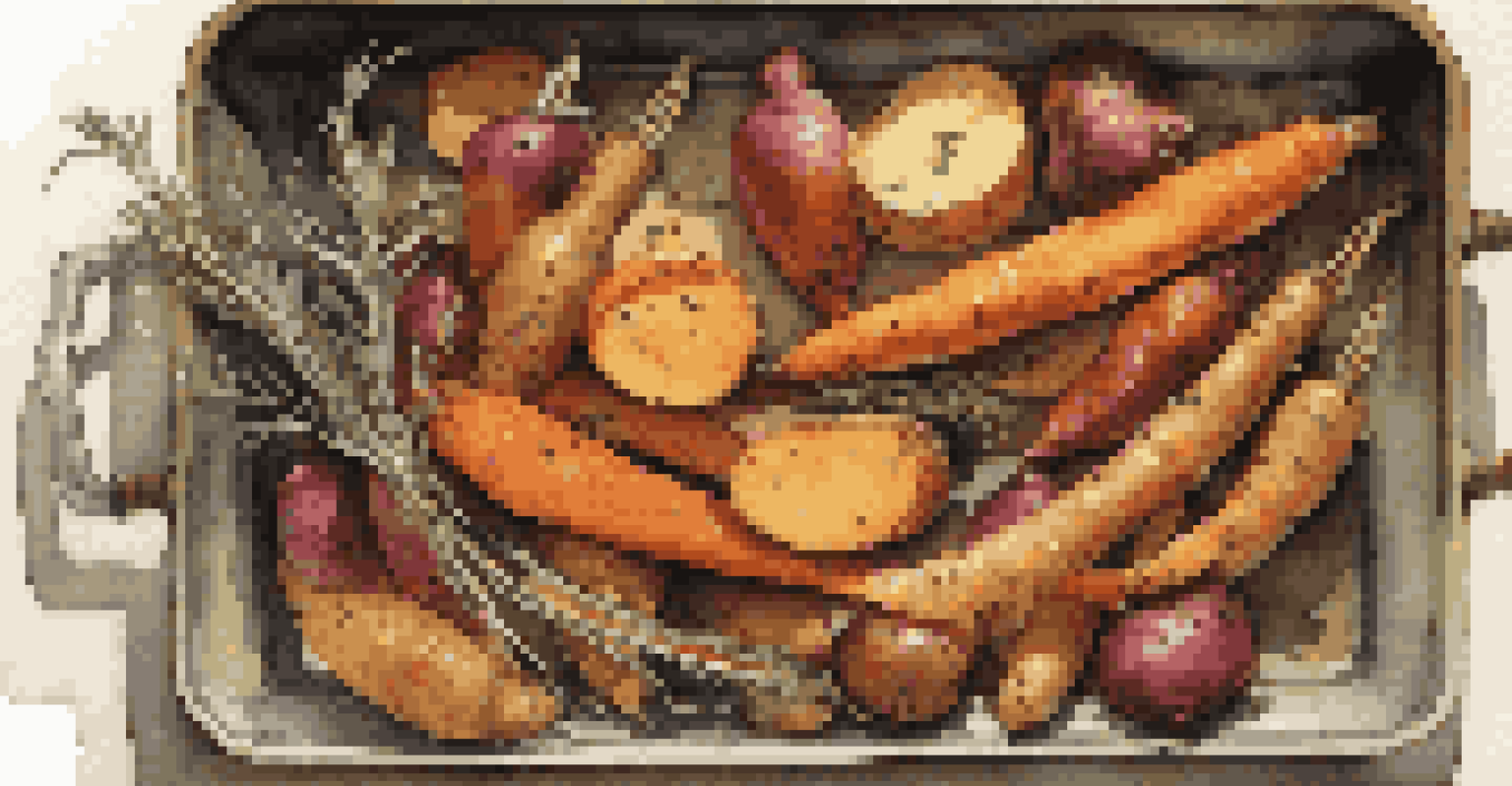Healthy Cooking Techniques for Gaining Nutritional Benefits

Understanding Nutritional Benefits of Cooking Techniques
Cooking is not just about making food taste good; it's also about maximizing the nutritional benefits. Different techniques can alter the nutrient content of ingredients, so it’s important to choose wisely. For example, some methods may preserve vitamins better than others, impacting your overall health. Understanding these techniques can help you make informed choices in the kitchen.
Cooking is like love. It should be entered into with abandon or not at all.
When you cook vegetables, for instance, boiling them can lead to significant nutrient loss, particularly of water-soluble vitamins like vitamin C. On the other hand, steaming retains more of these essential nutrients, making it a better choice. It’s about finding the balance between flavor and nutrition, ensuring your meals are both delicious and healthful.
Incorporating various cooking methods into your routine can keep your meals exciting while still focusing on nutrition. Whether you prefer roasting, grilling, or sautéing, understanding how each method affects the nutrients can guide you in creating healthier dishes.
Steaming: A Simple Way to Retain Nutrients
Steaming is one of the healthiest cooking methods available, and for good reason. It involves cooking food using steam, which helps to retain vitamins and minerals that may otherwise be lost in boiling water. This technique is particularly beneficial for vegetables, allowing their vibrant colors and flavors to shine while keeping their nutritional value intact.

Moreover, steaming is a quick method that allows you to prepare meals in a matter of minutes. Imagine a colorful medley of broccoli, carrots, and bell peppers, all cooked to perfection while maintaining their crunchiness and nutrients. This makes it not only a healthy choice but also a practical one for busy schedules.
Choose Cooking Methods Wisely
Different cooking techniques can significantly affect the nutrient content of food, making it essential to select methods that preserve health benefits.
To elevate your steamed dishes, consider adding herbs, spices, or a splash of lemon juice afterward. This not only enhances the flavor but also keeps the health benefits front and center, making your meals enjoyable without compromising on nutrition.
Grilling: Bringing Out Natural Flavors
Grilling is another fantastic technique that not only enhances the flavor of food but also supports healthier eating. The process allows excess fat to drip away from meats and vegetables, resulting in lower calorie dishes. Plus, the high heat creates a delicious char that adds depth to your meals.
Let food be thy medicine and medicine be thy food.
When you grill vegetables, they caramelize beautifully, intensifying their natural sweetness without the need for added sugars or fats. Think of grilled zucchini or bell peppers tossed with a little olive oil and herbs – it’s a simple yet flavorful way to enjoy your veggies.
One of the key advantages of grilling is its versatility. You can grill almost anything, from meats to fruits, allowing you to experiment and discover new favorite combinations. Just be mindful of marinating your proteins in healthier options like yogurt or citrus juices to keep them moist and flavorful without adding too many calories.
Roasting: Unlocking Rich Flavors and Textures
Roasting is a beloved cooking method that transforms ingredients into rich, flavorful dishes. By cooking food in the oven at high heat, you can achieve a beautifully browned exterior while keeping the inside tender. This method works wonders for both vegetables and proteins, enhancing their natural flavors.
For instance, consider roasting root vegetables like sweet potatoes or carrots. The process caramelizes their natural sugars, resulting in a sweet, satisfying side dish that pairs well with almost any main course. You can elevate this by adding herbs or spices, making your roasted veggies a star on the plate.
Steaming Retains Nutrients Best
Steaming vegetables is a quick and effective way to retain their vitamins and minerals while enhancing their flavor.
Additionally, roasting allows you to prepare large batches, making it perfect for meal prep. By roasting a variety of vegetables and proteins at once, you can create a base for multiple meals throughout the week, all while focusing on nutritious ingredients.
Sautéing: Quick and Flavorful Cooking
Sautéing is a quick cooking technique that involves cooking food in a small amount of oil over high heat. This method is perfect for retaining the texture and flavor of ingredients, especially when it comes to vegetables. The fast cooking time helps to keep their vibrant colors and nutrients intact.
Imagine a colorful stir-fry, with crisp bell peppers, snap peas, and carrots sautéed just enough to maintain their crunch. The addition of a flavorful sauce can enhance the dish without compromising its health benefits. Just be mindful of portion sizes when adding sauces or oils.
Sautéing is not limited to vegetables; you can also use this technique for lean proteins like chicken or shrimp. By cooking them quickly, you can lock in the juices and flavors, resulting in a delicious and nutritious meal that’s ready in no time.
Baking: A Healthier Alternative to Frying
Baking is often seen as a healthier alternative to frying, as it requires little to no oil and results in a lighter texture. This method is ideal for preparing everything from chicken to baked goods without the added fat that frying entails. With a little creativity, you can make delicious, guilt-free treats.
For example, baked chicken can be just as crispy as fried when prepared correctly. Using a combination of spices, herbs, and perhaps a light coating of breadcrumbs can give you that satisfying crunch. Plus, baking allows for even cooking, making it a reliable method for ensuring food is thoroughly prepared.
Fermenting Boosts Gut Health
Fermenting foods not only adds unique flavors but also enriches them with probiotics that support digestive health.
Baking is also a great way to experiment with whole grains and healthier ingredients in your favorite recipes. Consider making baked oatmeal or whole grain muffins instead of traditional versions, allowing you to enjoy the flavors you love while boosting the nutritional content.
Blanching: A Quick Nutrient Boost for Vegetables
Blanching is a cooking technique that involves briefly boiling food and then quickly cooling it in ice water. This method is particularly effective for vegetables, as it can help preserve their vibrant colors and nutrients. It’s a perfect way to prepare vegetables for freezing or to enhance their texture for salads and stir-fries.
When you blanch vegetables like green beans or asparagus, they retain their bright green color and crisp texture, making them much more appealing. This quick cooking method also helps to remove any bitterness, allowing the natural flavors to come through.

Additionally, blanching is a great way to enhance the digestibility of certain vegetables, making them easier on the stomach. By incorporating this technique into your cooking routine, you can enjoy fresh, flavorful veggies that pack a nutritional punch.
Fermenting: A Unique Way to Boost Gut Health
Fermenting is a fascinating cooking technique that not only adds flavor but also boosts the nutritional value of food. Through the fermentation process, beneficial bacteria break down sugars and starches, resulting in foods that are rich in probiotics. These probiotics are essential for gut health and can improve digestion.
Think of classic fermented foods like yogurt, sauerkraut, or kimchi. These foods are not only delicious but also provide a variety of health benefits, including enhanced immune function. By adding fermented foods to your diet, you can enjoy a unique flavor profile while reaping the rewards of improved gut health.
Fermenting at home can be an enjoyable and rewarding activity. With just a few ingredients and some patience, you can create your own probiotic-rich foods, incorporating them into your meals for added flavor and nutritional benefits.